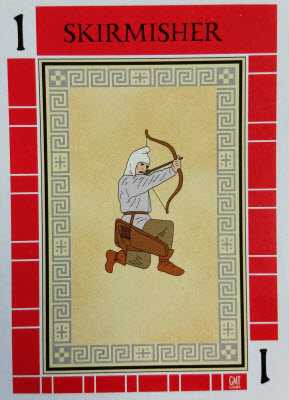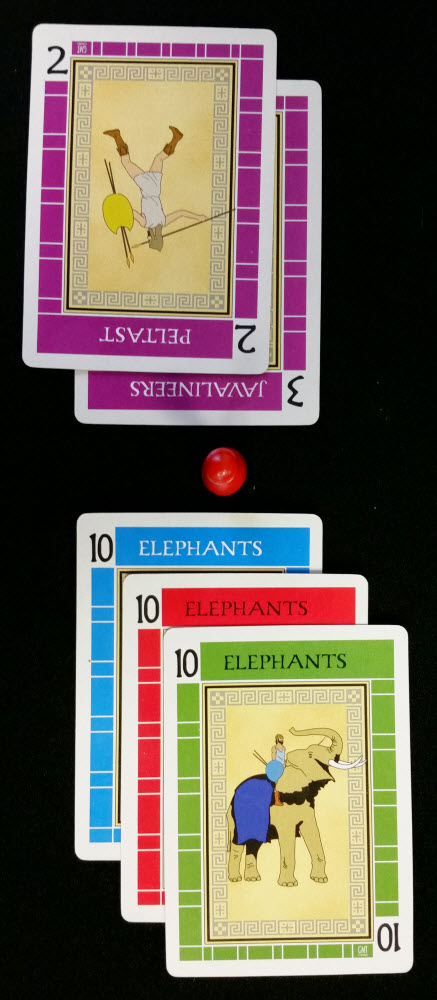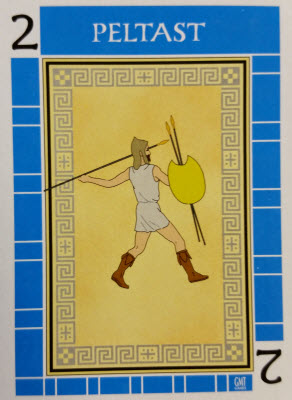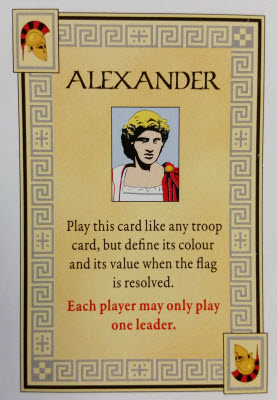When viewed from afar, war is often portrayed in systematic and structured ways. History books always talk about this battle, or that general in a very methodical way. In practice, waging war, regardless of its scope, era, or participants, is always an abject lesson in organized chaos. Things routinely can (and do) change in very unpredictable ways, turning assured wins into routs and guaranteed losses into surprise victories. Yes, war is a very messy thing.
The armies and groups taking part in those wars, however, can be incredibly well organized.
Well, at least until the fighting starts.
The Premise
Loosely based on ancient battles during the time of Alexander the Great, both players take the up the mantle of clashing military commanders. By strategically placing cards on to the battlefield, players look to capture enough territory through a mix of managing limited resources and outmaneuvering their enemy.
The Rules
Battle Line is a compact tactical card game for two players and is almost immediately playabl. The game consists of just two decks and nine pawns, called Flags. The Troop deck is comprised of card sets numbering 1-10 and separated into six different colors. The ten card Tactics deck is made up of unique cards that include such things as “wild” cards and those that affect the outcome of different battles.
To begin the game, all Flags are placed in a row. Players then cut the Troop deck and compare the displayed results. The winner of the cut deals each player seven Troop cards; the non-dealer becomes the starting player.
Battle Line takes place in a series of short turns. First, the player puts one of their cards into play. A Troop card may be placed at any unclaimed Flag that has less than three cards on their side. Troop cards are used to create Formations, in an attempt to defeat the opposing side at that location. Some Tactics cards are also placed at Flags; others are discarded after use.
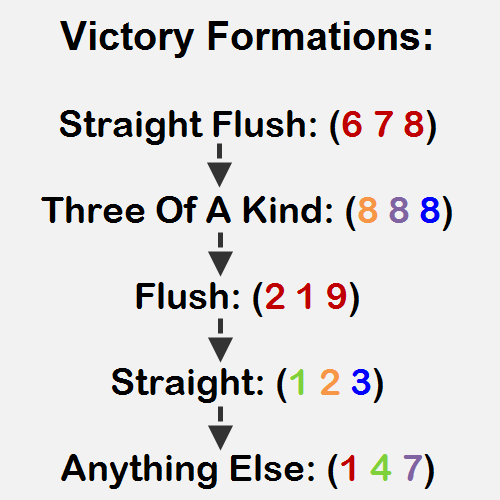 Next, the player may attempt to claim one or more Flag locations. To claim a Flag, the player must have three cards of theirs at the location and can demonstrate via information on the board that the other player cannot beat their Formation. Battle Line has five Formation ranks, the order of which is resolved in a near poker-like fashion.
Next, the player may attempt to claim one or more Flag locations. To claim a Flag, the player must have three cards of theirs at the location and can demonstrate via information on the board that the other player cannot beat their Formation. Battle Line has five Formation ranks, the order of which is resolved in a near poker-like fashion.
Lastly, the player draws a card. They may draw from either deck, but players are limited to using one Tactics card more than the opponent at any time. The other player then takes their turn.
Turns alternate until one player has claimed either three adjacent Flags or any five out of nine. At that point, the game immediately ends. That player has shown that they are superior ancient warfare strategist and may now stake claim to all of Asia Minor.
The other player may want to get used to paying tribute, lest the meet a, shall we say, pointed end.
Looking At The Bigger Picture
Battle Line initially appears to be a very basic card game with little function, and for the first few turns…that’s actually rather true. With nine different battlegrounds to compete over, there is a fleeting belief that you can haphazardly throw cards down and expect favorable results. That idea quickly subsides, however. Much like how Chess becomes more complicated once the pieces start moving, so too does Battle Line reveal that it’s deceptively deeper than it first appears.
Part of this is because of the permanency of your decisions. With the exception of three Tactics cards, your Troop cards cannot be changed or removed once deployed. As the game progresses beyond those first few open-ended turns, figuring out which card to play becomes increasingly important since each card is unique and it’s almost impossible to undo down the line. Like real battle, misplays can be quite costly.
Tied into that is the reality that, with each card you place and each Flag claimed, the available card slots to choose from steadily decreases. Having more cards in play gives you a better picture of the battlefield and provides you with the means to make more informed decisions on what to do next, but the gravity over where your cards should go increases as well.
Battle Line does a fantastic job of ratcheting up this game tension, with each turn become more and more important – right until the end. It’s not unlike a game of Rummy, where you must invariably choose whether you want to save a card for one set or another. Thus, it’s not uncommon to attempt to hold out as long as possible on playing certain cards in the hopes of drawing the one you truly want at a particular location but because you are forced to play a card each turn, there will come times when you’ll have to concede one location to save another. With each Flag claimed, this effect is compounded.
A Poor Tapestry
It’s a good thing that Battle Line’s strength is undoubtedly in its gameplay, because relying on the game’s artwork for success would make it hugely disappointing otherwise. Indeed, if not for the fact that most of the time you’re staring at the colors and numbers on your cards rather than the game’s lackluster visuals, this would be a significant detraction from the game’s overall worth.
Nevertheless, it can’t be overlooked that the most appealing artwork in the game comes on the back of the cards. Even taking into account that the artwork is deliberately designed to reflect the simpler aesthetic styles of its ancient Greek theme, most of the graphics lack any depth or detail, making most of what you see feel unfinished at best, or poorly done at worst.
The same can be said of the game’s tacked on and surface-laden theme. It is fitting, for instance, that the card values correspond to their respective unit strengths, with skirmishers and javalineers on one end and heavy cavalry and elephants on the other. Yet this doesn’t actually translate to their in-game use for determining victories.
It’s quite hard to imagine that the right mix of a couple spear throwers and some hoplites would actually thwart three equally sized groups of heavy cavalry.
Moreover, there is very little within the theme that anchors itself to any point in the ancient world it’s supposedly representing, save for the two Tactics Leader cards. Only Alexander the Great and Darius (presumably Darius III) are mentioned by name, but there’s no guarantee that either card will see play.
Plus, you wouldn’t want to pretend to be Darius III anyhow: he lost almost every encounter with Alexander and was legendary for fleeing battles even when his side was winning.
Immersionists, it would be very wise to skip this battlefield and fight again another day.
That all being said, for most the game’s uninspired aesthetics aren’t that detrimental to the game’s general worth. Very little of Battle Line’s theme factors into actual gameplay, reinforcing the fact that this is primarily an abstract tactical card game with some window dressing more than a game bristling with flavor.
Drawing Some Lines of Battle
Unsurprisingly, Strikers are going to be the most enticed by Battle Line. With a singular goal and being able to test their acumen against an opponent in a half hour time span, Battle Line is the type of contest right within their wheelhouse. They may not find luck of the draw to be the most ideal mechanic, but since it affects both players equally, it’s an acceptable battlefield hazard.
However, there can be some consternation over the potentially game-changing effects of Tactics cards, as they’re more asymmetrical and unpredictable. Of course, they are free to either also embrace their use, or by opting not to draw any Tactics cards they prevent their opponent from using them either. Indeed, if a player has drawn a couple Tactics cards, it’s a viable strategy to not draw any, leaving your opponent with unplayable cards in their hand.
Most Tacticians should also enjoy these clashes. Whether it’s utilizing a well-timed Tactics card or simply going through the puzzle-like permutations of card placement as the game unfolds, they’ll find this game straightforward but pleasantly stimulating. Battle Line rewards those with a considered approach, and although it doesn’t have a ton of room for many surprise moves, there is still plenty of space for planning. The game never strays into territory that invites analysis paralysis, but it still makes you think.
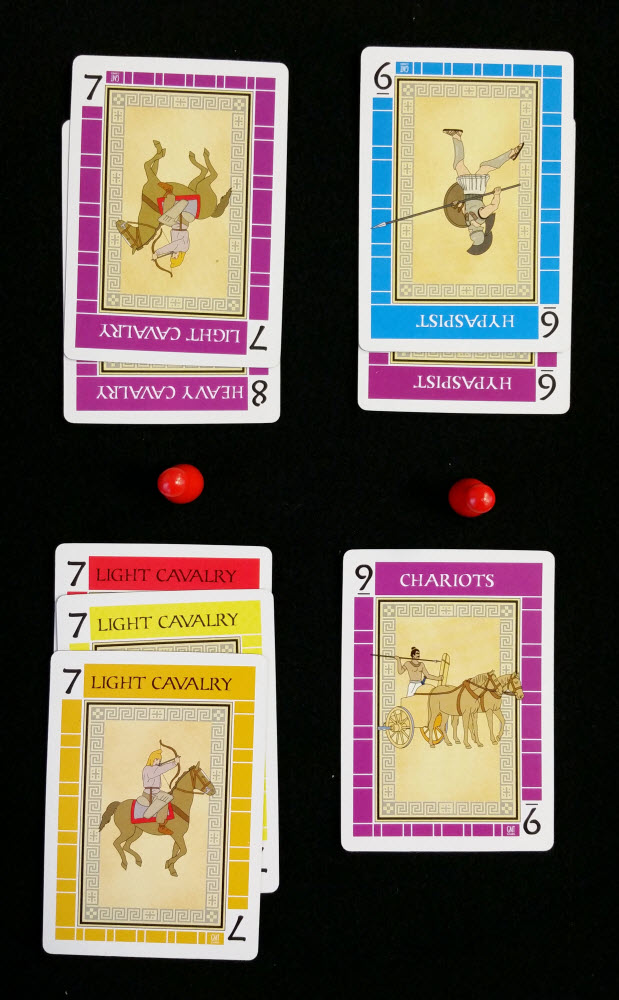
The triple 7 player can claim this Flag, showing that with Purple 6 and 9 out, the other player cannot be defeated.
On the other hand, it’s for these same reasons that Daredevils and Architects shouldn’t engage in this fight; there just isn’t enough here to hold their interest. Because of its abstract nature, Battle Line offers neither the room for multiple strategies nor the ability to branch out beyond its almost rudimentary ruleset, and both groups would ultimately feel stifled.
Similarly, it’s best that Socializers not attempt to don any armaments for this one. Time isn’t the deciding factor here to pass on this game. Instead, between the duelist style of play and the primary focus being to outmaneuver your opponent with forethought (and a bit of luck), this strategy-centric bout isn’t the type of game they’re generally after.
The Takeaway
Battle Line is a seminal example of a game that doesn’t require a ton of pieces and lengthy rules to be a rewarding experience. Much like classic playing card games, Battle Line provides players a healthy mix of simplistic gameplay with increasingly calculated decision-making. Playthroughs are brief and low-key, but players will quickly be thrust into making important choices over which cards to play when, as both sides strive to turn the battle in their favor. Battle Line’s premise is thinner than ancient parchment, and the artwork is quite Spartan, but with an impressive amount of replayability, it still passes muster. Like any good soldier, Battle Line is quick, to the point, and portable for wherever it needs to go, making it an easy addition to any player’s legion of games.
Battle Line is a product of GMT Games.
Cardboard Republic Snapshot Scoring (Based on scale of 5):
Artwork: 1.5
Rules Clarity: 5
Replay Value: 5
Physical Quality: 4
Overall Score: 4.5
Photo Credits: Eddie Izzard by HBO.

